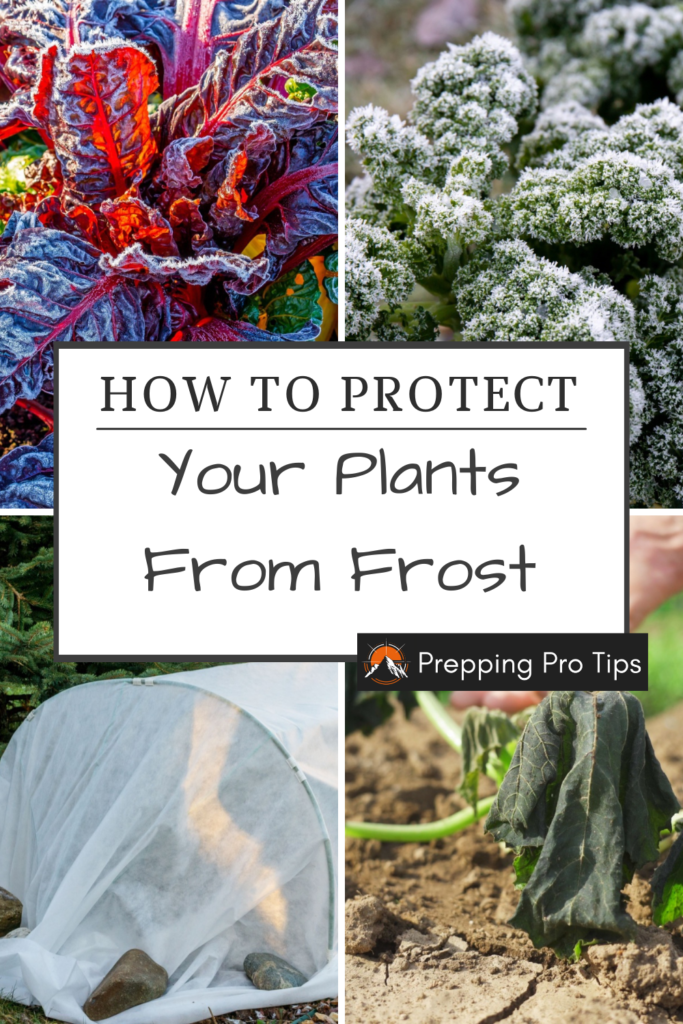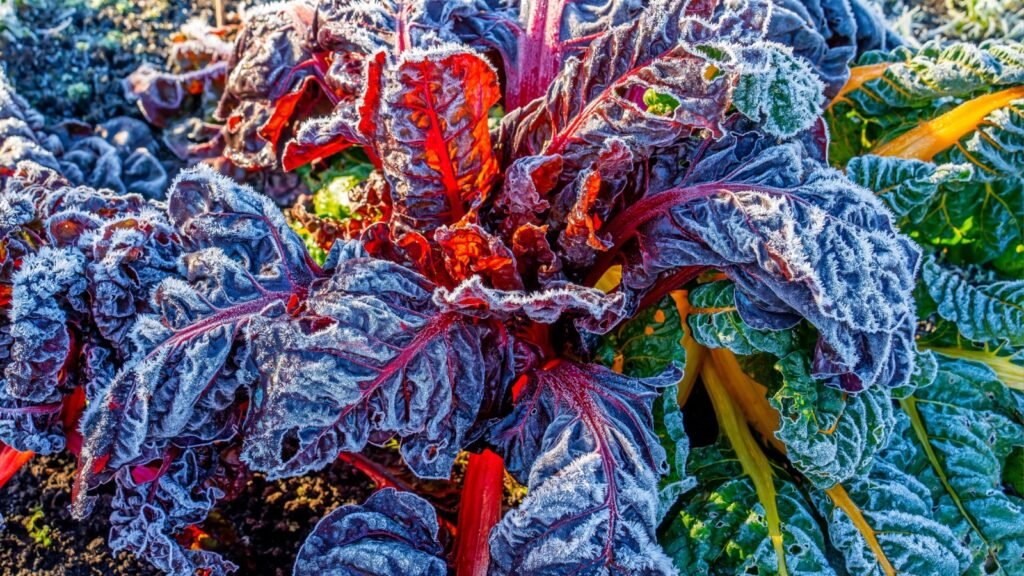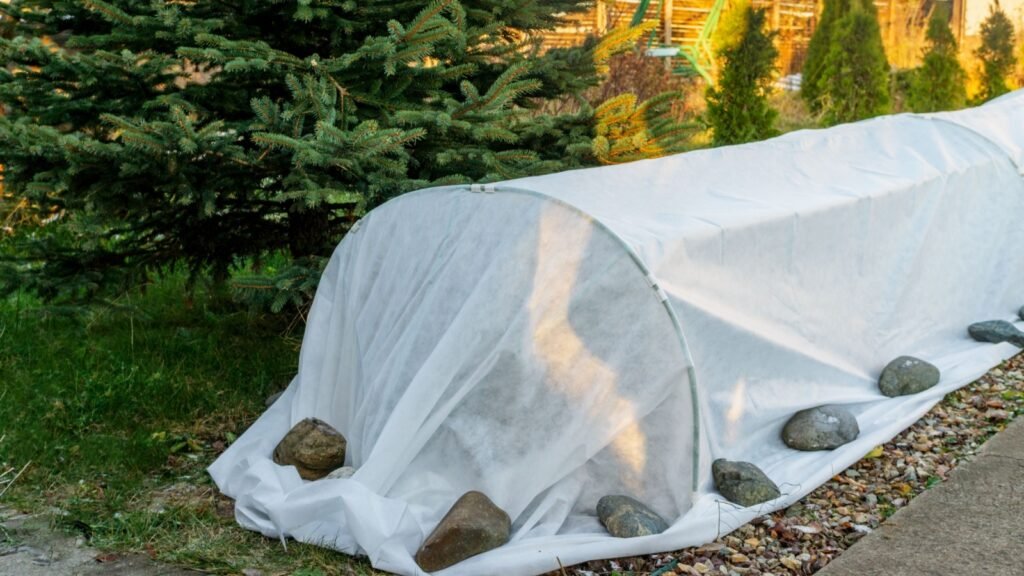Gardening requires a green thumb and a keen awareness of the weather. This is especially true for the risk of frost that can damage or kill your plants. Frost damage can occur even when air temperatures are slightly above freezing. This causes ice crystals to form on the plant cells, leading to dehydration and cell wall damage. Cold air can exacerbate this issue by seeping into the garden, so you’ll need to be ready to use fabric covers and insulating materials to create a warmer microclimate and protect plants from freezing temperatures.

You can shield your plants from the harsh effects of frost by using various frost protection strategies. These methods range from simple solutions, such as covering plants with frost covers, to more permanent structures like cold frames or greenhouses. The key is to understand the signs of impending frost and to take prompt action. By doing so, you can ensure that your garden continues to thrive in colder conditions.
Frost can strike quickly and often when you least expect it. This makes timing and preparation vital components of frost protection. There are numerous ways to safeguard your garden, and some might even be materials you already have on hand. With the right approach, you can provide a defense against the cold, potentially saving your plants from significant damage.
Understanding Frost and Its Effects on Plants

Frost occurs on clear, calm nights when the temperature dips to at least 32°F (0°C). The cold causes water vapor in the air to transition into ice on surfaces, including plants. This happens because objects like plant leaves can become cooler than the air around them. When plant tissues freeze, ice crystals can form inside, which may damage plant cells by causing them to burst.
Types of Frost
There are several types of frost, but the two main ones that affect plants are hoarfrost and black frost. Hoarfrost is the white coating you see on cold mornings, which forms when dew freezes.
Black frost occurs without visible ice because the moisture in plant cells freezes. Black frost is more deadly and often results in a blackened appearance of the plant tissue. Frost-tolerant plants can handle some chill, but frost-tender plants are likely to be damaged or killed by freezing temperatures.
Light frost can cause minimal damage to certain vegetables and annuals, but it can still be harmful to more sensitive plants.
Identifying Frost Damage on Plants

You can identify frost damage by the wilting or darkening of plant tissue, which often appears after thawing. Leaves may turn brown or black and become limp. Frost damage is most apparent when tender new growth suffers first. In contrast, more resilient parts of the plant or inherently frost-tolerant plants might escape unharmed. If you notice that your plant’s normal, healthy green has shifted to an unsightly brown or black, it’s time to assess and address potential frost damage.
Pre-Frost Preparation Strategies
Before the first frost hits, your ability to prepare effectively can be the difference between a thriving garden and one that succumbs to the cold. Pre-frost strategies are all about taking proactive steps to ensure your plants have the best chance to withstand chilly temperatures.
Selecting the Right Plant Varieties

When you’re stocking your garden, focus on hardy plants if you live in an area prone to early frost. These varieties are more likely to survive sudden temperature drops. For instance, kale and brussels sprouts can handle cold weather well. On the flip side, tender plants like tomatoes and peppers are more susceptible to frost damage and should be planted after the last frost date to minimize risk.
Tropical plants are particularly vulnerable to frost and need protection to avoid damage to flowers, developing flower buds, and newly emerged foliage. Vulnerable plants, in general, should be carefully monitored and protected from cold snaps to prevent damage or loss.
Pay Attention to Weather Forecasts
Keep a keen eye on the weather forecast. Knowing when temperatures dip and the first frost is likely to touch down gives you an edge because it lets you proactively protect tender plants. Mark the frost dates on your calendar and monitor temperature predictions regularly. This vigilance allows you to employ protective measures, like covering plants or moving potted ones indoors, right before frost is expected.
Choose the Right Planting Location
One of the keys to protecting plants in your vegetable garden is choosing the the right location to begin with. Opt for planting sites that maintain consistent warmth longer, such as southern-facing slopes. Additionally, areas sheltered from the wind by fences or natural landforms can protect plants from cold pockets of air that settle after the sun goes down.
You’ll still need frost blankets or other row covers, especially in a deep freeze, but strategically placing your plants gives them the best chance of survival in a sudden cold snap.
Frost Protection Techniques
Protecting your plants from frost involves a combination of insulation, watering practices, and creating microclimates. These techniques ensure the survival of your plants through cold snaps.
Insulation Methods
Insulation is key to protecting your plants. Materials like straw, leaves, or mulch can be spread around the base of your plants to insulate the ground. This helps to trap heat and maintain steady soil temperatures. For added protection, you can cover your plants with fabric covers or burlap sacks during the night when frost is most likely. Just make sure to remove the covers during the day to allow air circulation and prevent overheating.
Watering Practices Prior to Frost
Watering your plants before an expected frost can help protect them. Moist soil holds heat better than dry soil, warming the air near the ground. Water in the morning so the plants have time to absorb it before temperatures drop in the evening. However, avoid overwatering, as soggy soil can harm the plant roots.
Creating Protective Microclimates
Cold temperatures can significantly impact plant health, making it essential to create microclimates to protect them. Microclimates are small areas where the climate differs from the surrounding area. You can create microclimates by strategically placing plants near walls or larger plants that can shield them from wind—a major exacerbator of frost.
Additionally, using raised beds or cloches can trap heat and protect individual plants or rows. Vent any protective structures during the day to regulate the temperature and prevent the build-up of excess moisture.
Coverings to Protect Plants from Frost
As frosty weather approaches, ensuring the survival of your garden means taking specific actions. Covering your plants is an effective method for frost protection, but it requires proper materials and techniques to be successful.
Proper Use of Blankets and Burlap
Using blankets provides warmth for your plants on cold nights. It’s critical that the blanket doesn’t touch the foliage, as contact can transfer cold to the plant. Elevate the blanket with stakes or frames, draping it gently over your plants, and extend it to the ground to trap heat effectively. Burlap, a more breathable option, serves similarly but is best suited for larger shrubs and trees.
Applying Plastics and Frost Cloths
Plastics are great for trapping heat, but they must not touch the plants, since they can cause damage where contact occurs. Ensure there is a sturdy framework to support the plastic sheeting above the plants. Frost cloths are specially designed fabrics that insulate while allowing moisture and light to reach the plants during the day. Wrap the cloth securely around your plants, using clothespins to fasten the cloth to the support structure. When temperatures rise, remove the plastic covers or frost cloths to allow fresh air and sunlight to reach the plants.
Securing Covers for Plant Protection

Finally, securing the covers is just as important as the covering material used. Whether you choose blankets, burlap, plastic, or frost cloths, make sure the edges are anchored to prevent wind from lifting the cover and exposing your plants to the cold. You can use heavy objects like bricks or stones to keep the material in place. This will help you keep your plants snug and protect them from frost damage effectively.
Caring for Plants After Frost Exposure
When you first inspect your plants after frost, assess their ability to withstand temperatures by looking for signs of visible damage such as blackened or softened areas on the leaves and stems, indicating that tissues have been damaged. New growth is often most susceptible, so pay special attention to tender buds and young shoots. It’s vital not to rush the removal of this damaged tissue. Give your plants a few days to show signs of recovery before you begin pruning. Damaged growth often acts as a protective barrier for healthy tissue further down the stem.
Cultivating a Resilient Garden
Creating a garden that thrives through the seasons, especially during frosty winter months, involves specific strategies for plant protection and soil management. Let’s explore how to nurture a hardy garden that can withstand chilly weather with ease.
Implementing Seasonal Gardening Tips
To ensure your garden is resistant to frost, start by selecting hardy plants that are acclimated to your region’s climate. These varieties are more likely to survive and even thrive during the colder months of winter and early spring. It’s crucial to understand that the timing of planting is just as important as the plant variety. For instance, garden tips commonly suggest sowing seeds at the optimal time for each plant to ensure they mature during the right season.
Wrap tender saplings in burlap or use cloches to shield them from frost, taking advantage of the insulation they provide. Old wisdom hints at the benefit of watering your garden before a frost – moist soil retains heat better than dry soil, offering a warm blanket for your plant roots. However, avoid overwatering as this may lead to soil freezing and root damage.
Fertilization and Soil Health Management
Your garden’s resilience is strongly tied to the health of your soil. Incorporating organic matter like compost into your soil can significantly improve its structure, helping plants to establish more robust root systems. Proper fertilization is a science; in preparation for winter, reducing high-nitrogen fertilizers can help plants to harden off, as too much nitrogen can stimulate growth that’s sensitive to cold. Instead, focus on fertilizers that support strong cellular development in plants.
Remember to test your soil’s pH and nutrient levels regularly, adjusting your fertilization methods accordingly. Healthy soil helps plants weather the cold better and ensures they come back stronger in the spring. The goal is to maintain a balance that promotes soil life, plant health, and high resistance to frost damage.
Frequently Asked Questions
When frost threatens your garden, taking the right steps can effectively protect your plants. Here are answers to your most pressing questions on keeping your plants safe during cold snaps.
What can I use to cover my plants to prevent frost damage overnight?
You can safeguard your plants from frost damage by covering them with materials like frost cloths, blankets, or even old bed sheets. These covers trap heat from the ground and shield your plants from the icy touch of frost.
Are there inexpensive materials that effectively shield plants from frost?
Yes, cardboard boxes or even upturned buckets can act as makeshift frost shields for individual vegetable crops. They’re a cost-effective solution and are often readily available.
Can watering my plants before a frost help in protecting them?
Watering your plants before a frost can help because moist soil retains heat better than dry soil. However, it’s important to water early enough so the water doesn’t freeze and damage the plant roots.
What is the best way to safeguard potted plants on a porch from frost?
For potted plants, moving them closer to your house or indoors can provide protection from the cold. If they must stay outside, wrap the pots with burlap or bubble wrap and use a cover over the plants to keep them warm.
How can I create homemade frost covers for my garden?
You can make homemade frost covers by draping old blankets or sheets over a simple frame built around your plants. Ensure the material is light enough to not damage the plants but thick enough to provide insulation.
At what temperature should I start covering my plants to shield them from frost?
Begin covering your plants when nighttime temperatures are forecast to drop below 35°F. Frost formation typically occurs when temperatures hit the 32°F mark or lower.
It’s better to be cautious and protect your plants earlier rather than risk frost damage.
